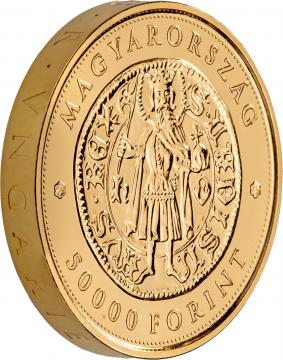|

The Hungarian Mint has issued a new 50,000 forint in its Hungarian ‘Gold Florins from the Middle Ages’ program that began in 2012. The new coin, the eighth in the series, called the ‘Gold Florin of Ladislaus V,’ is offered in a single and in a piedfort version which is four times the weight of a normal coin. This is the piedfort.
The obverse shows the reverse of the gold forint issued by King Ladislaus V in the center. St. Ladislaus I of Hungary is standing in the center holding a poleaxe with a short-handle and a globus cruciger surrounded by an inner border. Inside the beaded border running around the edge is the inscription ‘MAGYARORSZÁG’ (HUNGARY), with the denomination ‘50000’ and the lettering ‘FORINT,’ separated by flower motifs.
On the reverse, in the middle, partly extending beyond the circular, grid-patterned central field, bordered by a beaded edge, is the figure of King Ladislaus V sitting on the throne. This representation was inspired by an engraving in the Brno issue of the Thuróczy Chronicle, published in 1488. Beneath is the king’s coat of arms. To the left of the king is the mint mark ‘BP.’ with the minting year ‘2024’ underneath. To the right is the designer’s mark of sculptor Tamás E. Soltra. Inside the beaded border running along the edge of the reverse, is the inscription ‘V. LÁSZLÓ 1453-1457 ARANYFORINTJA’ (LADISLAUS V 1453-1457 GOLDEN FLORIN).
The gold coin conforms to the traditional gold ducat standard. It is struck in .986 fine gold and weighs 13.964 grams (4 ducats). The diameter is 20 mm.
The edge is decorated with a unique Latin inscription ‘+ LADISLAVS ∙ D ∙ G ∙ R ∙ VNGARIE’ (LADISLAUS DEI GRATIA REX UNGARIAE) on the edge, meaning ‘Ladislaus, king of Hungary by the grace of God.’ The mintage limit of the piedfort collector coin is 500 pieces.
Hungary issued the gold coin of Charles I as the first piece in the ‘Hungarian Gold Florins from the Middle Ages’ series in 2012 with the aim of providing a full picture of good quality coins in medieval Hungarian money history, which preserved their value and were frequently accepted by foreign merchants as well. To be true to history, the first piece of the series was followed by the golden florin of Louis I in 2013, Queen Mary in 2014, Sigismund in 2016, Albert in 2018, Vladislaus I in 2020 and John Hunyadi in 2022. |















